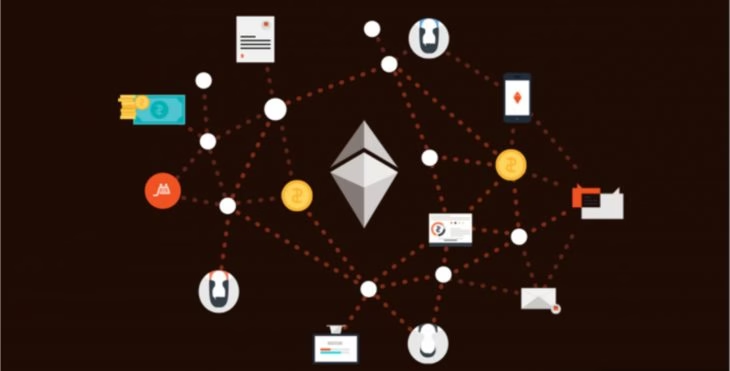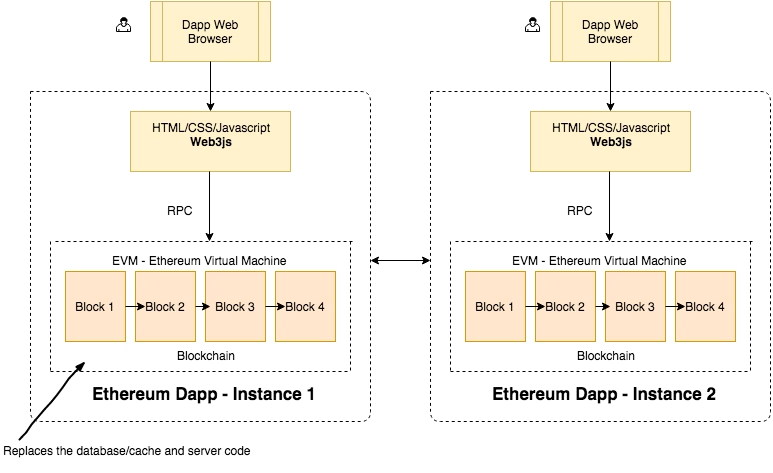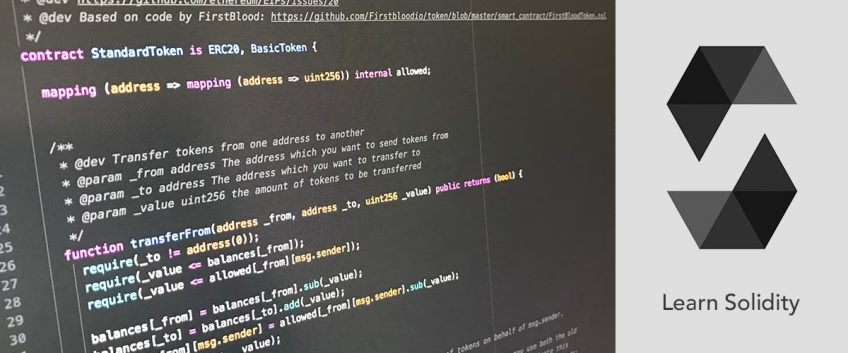- Developers
- Developer Blog
- Blockchain Development
- How to Make Decentralized Apps

profile

By Aran Davies
Verified Expert
8 years of experience
Aran Davies is a full-stack software development engineer and tech writer with experience in Web and Mobile technologies. He is a tech nomad and has seen it all.
Interested in how to make Decentralized apps? In this article, we will show you how to make a DApp and answer the most popular questions about Decentralized application (dApp) development: What are the requirements of a decentralized application? What are the requirements of a decentralized application? How to build a DApp from scratch? How much does it cost to create a decentralized exchange?
Let’s get started!
In this article
- How to build a decentralized application
- Developing decentralized apps
- Examples of simple decentralized apps deployed to the Ethereum platform
- The special place of Ethereum when you build decentralized applications (DApps)
- Frequently Asked Questions on decentralized apps
How to build a decentralized application
A decentralized application (DApp) is an autonomously operating software application that typically uses smart contracts and runs on a distributed ledger system such as blockchain.

When you decide to build a decentralized application, you should know that the process comes with its own unique challenges.
Features such as decentralization and creating a smart contract require a unique developer skillset. It is for this reason that hiring the services of a developer who has experience in developing a decentralized blockchain app is a good idea.
For larger projects, it is definitely a good idea to outsource the project to a professional dev team so that they can do all the hard work for you. You may also need to think about hiring a company to help you handle your ICO.
Using an ICO to fund your Decentralized Apps Project
Step 1: Know your project
Before you do anything, it is really important that you understand your project from top to bottom.
Not only will you need to understand the how your application intends to solve whatever problem it has been designed to, but you will need to also understand such things as why the application needs to be a decentralized app, how much it is going to cost, and whether or not there is a market for it in the first place?
Step 2: Create a whitepaper
Once you have a clear vision of what your app is, how it will function, and where it will be in 5 years, you can now begin the process of writing a great whitepaper to help investors understand your vision.
If you need help with this then you can read an article I wrote recently for the DevTeam.Space blog via this link: “How to Write an ICO Whitepaper”.
Step 3: Launch an Initial Coin Offering

Get a complimentary discovery call and a free ballpark estimate for your project
Trusted by 100x of startups and companies like
ICOs are a great way to raise the funds that you will need to develop your project. Unlike IPO‘s, they don‘t require you to relinquish any control in the company through shares, etc. to raise the money you need.
For a guide on how to launch an ICO please read my article published here.
Step 4: Start Building Your App
There are lots of approaches you can take in order to build a decentralized app. Some are a lot easier than others as they utilize the resources provided by organizations such as The Ethereum Project, etc.
The majority of low scale decentralized apps now utilize Ethereum‘s smart contract service in some form or another. Since they already have a vast amount of resources that are already available for development use, Ethereum represents an excellent way to reduce the time and money needed in order to build a decentralized app.
What follows are the main steps and considerations vital to building a decentralized application.

Developing decentralized apps
Development Step 1: Deciding on what technology you will use – Defining your Environment
You will need to determine exactly what technology you are going to use for these key areas of development:
- Database
- Frameworks
- Hosting
- Frontend
- Frontend contracts
- Contract‘s programing language
- Operating System
- API‘s
- Development server
Development Step 2: Setup the project
This step will involve firstly installing the development framework.
Next, you will need to set up all the tools you will need for the front end development of your app. Try to always develop in a language your entire development team is familiar with. This might seem obvious but it is amazing just how many projects ignore this rule.
For Ethereum, developers can use Solidity or Serpent.
If you intend to use Ethereum then Truffle is an excellent development platform.
Development Step 3: Code the application
If you are new to all this, and if this is the first time of you building a decentralized app, then start by using Solidity, as it is the easiest language to use, thanks to its similarity to JavaScript.
Solidity is an excellent programming language for coding the smart contracts that your decentralized application will need.
Smart Contracts are a central part of creating decentralized applications that developers will need to know and have experience with. As I have already stated, creating smart contracts directly to the Ethereum blockchain is by far the easiest way to create your own small-scale decentralized app.
Keep in mind that blockchain transactions cost money. Known as “gas”, this is the money that goes to the miners who process transactions. In the case of Ethereum, gas will be charged in Ether.
The next step is to complete front-end development
Remember when you get around to designing your UI to keep it snappy and appealing to users. Functionality is key to a great UI, so make sure that it has all the features that a user might require, and that they are located in the places where they are most needed.
So, for example, if you are creating a decentralized identification system, then you should ensure that the relevant information is displayed in a way that makes it easier to interpret. There is nothing worse than not being able to find the information or buttons you need.
Development Step 4: Deploy and Test Your DApp
Before deploying your app to the blockchain, it is worth noting that any deployed smart contract code will be unalterable and forever stored on the blockchain.
Though it is possible to ’overwrite‘ the old code by creating new blocks on the chain, you should always make sure your code is 100% correct before deploying.
You should always ensure that you only fully launch your DApp after it has been fully tested.
For this reason, all apps should have a test window built into their development. Before you reach the testing stage, you should arrange a meeting with your development team where you discuss all the variables that you will need to test.
With a voting decentralized app, for example, these variables will include single vote tests as well as high volume voting in order to test the blockchain network processing speed for minimzing network congestion, etc. You should also test to see how the app deals with repeat votes being cast by the same individual and attempts to alter the votes after they have been cast, etc.
Development Step 5: Launch Your App
Once your app has been tested, you will be ready to launch it. Choose a custom domain for the application so that it looks professional and then let everyone know it is up and ready.
Keep in mind that this will be the most intensive part of your marketing strategy since your ICO launch as you will need to keep the buzz going about your project.
Hire expert developers for your next project
1,200 top developers
us since 2016
Though the hardest part is behind you, the success of your new DApp is by no means assured. For this reason, you should keep up the same level of hard work and diligence that help you to you create a great app in the first place.
Let’s summarize the five steps:
- Choose the tech stack;
- Setup your project;
- Code the app and build the frontend;
- Deploy and test the app;
- Launch the app.
Examples of simple decentralized apps deployed to the Ethereum platform
The special place of Ethereum when you build decentralized applications (DApps)
There are multiple blockchain development platforms to build DApps. However, Ethereum has a special place. Ethereum has attained this stature due to the following reasons:
1. The Ethereum network has already proven its mettle in various use cases
Many entrepreneurs and developers use the Ethereum blockchain platform to build DApps catering to different use cases. The following are just a few examples:
A. DeFi (Decentralized Finance) apps
We know about the financial services and products offered by banks and financial institutions. A financial services institution acts as a central authority while offering these products and services. It uses centralized apps and centralized servers to manage all its software systems.
Entrepreneurs have built DeFi (Decentralized Finance) apps to offer financial products and services using distributed networks instead of a centralized network.
Decentralized lending, decentralized credit service, and decentralized prediction markets are a few examples of decentralized autonomous organizations using DeFi apps.
Entrepreneurs typically use the Ethereum blockchain platform to build decentralized network for DeFi apps. E.g., Uniswap, a company that has built the “Uniswap protocol” using the Ethereum platform. It’s a DeFi protocol.
B. DAO (Decentralized Autonomous Organization)
A DAO (Decentralized Autonomous Organization) is a community of users without a centralized leader. People build DAOs using a decentralized blockchain.
It enables users to make decisions by voting. These are users are community members. The community uses transparent rules to govern a DAO. It uses the decentralized peer-to-peer network to ensure democratic decision-making.
DAOs often fund important blockchain development projects, and they make funding decisions by consensus. Many such communities create DAOs using the Ethereum blockchain platform. MakerDAO is an example.
The rules of such DAOs are codified in Ethereum smart contracts. These are open-source, therefore, anyone can view the source code. This fosters transparency.
C. Stablecoin/ cryptocurrency
A stablecoin is a cryptographic token that intends to maintain a stable price. Stablecoins typically peg their price to a real-world asset like USD, gold, etc.
Entrepreneurs often create stablecoins using the Ethereum blockchain platform. DAI is an example. MakerDAO has created DAI, and it’s based on the Ethereum network.
D. NFTs (Non-Fungible Tokens)
NFTs (Non-Fungible Tokens) are cryptographic tokens that are unique and indivisible. These attributes make them ideal to tokenize digital artworks and collectibles. NFTs are very popular at the current time.
Many entrepreneurs build NFTs using the Ethereum Virtual Machine (EVM) and smart contracts codes on Ethereum. An example is Axie Infinity, a popular monster game based on the Ethereum blockchain.
2. The rich ecosystem of Ethereum blockchain development tools and resources
You too can take advantage of the rich ecosystem of Ethereum blockchain application development tools and resources. Creating your own DApp can be complex. The tools and resources in the Ethereum ecosystem can help though.
Consider the following examples:
A. Solidity/ programming language
Solidity is the main programming language for coding smart contracts for the Ethereum blockchain. You can code the front-end of an Ethereum DApp using common web development technologies like JavaScript, HTML, CSS, etc. Do you plan to access the DApp using Android or iOS devices? In whatever case, you must use established tools and frameworks for designing the mobile user interface.
However, DApps work by running smart contracts in the back-end. Ethereum developers code Smart contracts using Solidity, a proprietary programming language. It’s a powerful language with lots of useful features.
Hire expert developers for your next project
B. Remix/ React framework
“Remix” is an IDE (Integrated Development Environment) to code Ethereum smart contracts. It’s a DApp. Therefore, developers don’t need to download this IDE.
C. Ganache/ Ethereum development tool
Ganache is an easy-to-use blockchain client. Programmers commonly use it for Ethereum DApp development. You can install and configure it easily.
D. Web3.js/ development tool
Web3.js is a JavaScript-based Ethereum API. It’s user-friendly. You can install it using NPM (Node Package Manager), the popular tool.
Many software engineers use it for Ethereum DApp development. There’s a JSON interface for Web3.js too.
E. Truffle Suite/ Ethereum set of tools
The Truffle framework is a popular suite of tools for Ethereum blockchain development. It helps to code and organize smart contracts. You can test and deploy smart contracts using it.
F. Sepolia/ test network
Sepolia is a test network (“testnet”) for Ethereum. Test your Ethereum smart contracts using Ropsten before deploying them on the main network (“mainnet”). You don’t need real Ether (ETH) for testing smart contracts, therefore, you can use dummy Ether.
G. MetaMask/ software cryptocurrency wallet used
MetaMask is a browser extension as well as a crypto wallet. Many developers use it for Ethereum DApp development. Take the example of testing smart contracts on Ropsten. You can use MetaMask to obtain ‘dummy’ Ethers rather than using real ones to undertake app testing.
H. Tutorials/ development tool
You can find many Ethereum blockchain development tutorials. They cover a wide range of topics, e.g.:
- Solidity;
- How to install, configure, and initialize the different Ethereum development tools;
- How to use IPFS (InterPlanetary File System) with Ethereum;
- Coding smart contracts that are easy to debug.
You can also find overall Ethereum development tutorials on GitHub.
Final Thoughts
Wondering where you can get help to build a DApp?
If you find yourself lacking any of the skills or experience that you need to create decentralized apps, then why not take a moment to contact DevTeam.Space to let us know you project requirements? A dedicated account manager will contact you to explain how we can help.
DevTeam.Space is an innovative American software development company with over 99% project success rate. DevTeam.Space builds reliable and scalable custom software applications, mobile apps, websites, decentralized apps, live-streaming software applications, speech recognition systems, ChatGPT and AI-powered solutions, and IoT solutions and conducts complex software integrations for various industries, including finance, hospitality, healthcare, music, entertainment, gaming, e-commerce, banking, construction, and education software solutions on time and budget.
DevTeam.Space supports its clients with business analysts and dedicated tech account managers who monitor tech innovations and new developments and help our clients design, architect, and develop applications that will be relevant and easily upgradeable in the years to come.
Frequently Asked Questions on decentralized apps
DApps are better for certain tasks such as applications where data trustworthiness is vital. Since DApps are based on distributed ledger technologies, the data stored by them is immutable and is therefore trustworthy.
You can build a very basic DApp for a few thousand dollars. However, if you are looking to try to commercialize your app then you will need to spend considerably more to make it stand out from the crowd.
Get together a project plan and then fill out a project specification form on the DevTeam.Space website. The platform will then connect you with the most suitable DApp developers.

Alexey Semeney
Founder of DevTeam.Space
Hire Alexey and His Team To Build a Great Product
Alexey is the founder of DevTeam.Space. He is award nominee among TOP 26 mentors of FI's 'Global Startup Mentor Awards'.
Alexey is Expert Startup Review Panel member and advices the oldest angel investment group in Silicon Valley on products investment deals.


